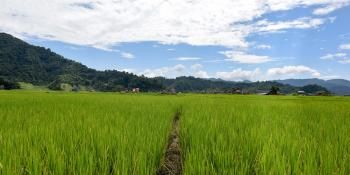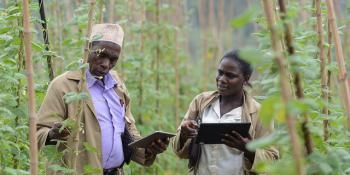Initiatives to increase food security and climate resilience of farmers in Uganda

Preliminary results from climate change adaptation and mitigation initiatives in Hoima, Uganda
Hoima in western Uganda is located to the east of Lake Albert. The site is a productive region and diverse in crop production, but it has been challenged by land degradation and declining soil fertility. Due to soil erosion, rising temperatures and increasing rainfall variability, farmers in the region have been exposed to declining food security.
The CGIAR Research Program on Climate Change, Agriculture and Food Security (CCAFS) and partners have been implementing climate change adaptation and mitigation practices to increase farmers' food security. A recently published info note highlights some of the initiatives and preliminary results to shed light on the progress in achieving household food security in Hoima.
Collective action for climate change adaptation
CCAFS and one of Uganda's agricultural research and development institutes (Bulindi ZARDI) work with twot local community-based organizations (CBOs) to build their capacity; CBOs were trained on improve agronomic practices and livestock management to improve productivity.
Since 2014, CBOs have expanded their membership from 140 to 1670 households, and 60% of the CBOs' members are women. CBOs have mobilized USD 50,000 in a community innovation fund, and due to flexible replayment terms and affordable interst rates, their members can borrow from the fund for investing in agricultural activities.
Climate information services for improved on-farm decision-making
Farmers in Hoima used to rely on indigenous knowledge for weather forecast. This changed in 2012, when Bulindi ZARDI partnerd with farmers to integrate scientific forecasts for better on-farm decision making.
As a result, CBO members have access to weather information through mobile phones, with over 620 households using climate information services to increase their ability to manage climate risks.
Improved crop varieties for increasing food security
Diversifying crop choices, including improved crop varieties, improves climate risk management and ensures that households' nutrition needs are met. This is why it is a big success that by 2016, over 90% of the households in Hoima introduced at least one new crop variety. For example, by the end of 2016, over 1200 households have planted improved sweet potato and cassava varieties that were developed through partnerships; the sweet potato with the International Potato Center (CIP), and the cassava with International Institute for Tropical Agriculture (IITA).
CBOs have been instrumental in advancing the scaling out of these varieties to more farmers in neighboring villages. They have promoted the uptake of these varities through village demonstrations, field days and multiplication of planting material.
Agroforestry for soil conservation and improved nutrition
Farmers in Hoima are now planting fruit trees such as mango varieties that produce bigger, more delicious fruits. Improved mango trees produce 1000-1500 fruits compared to the local variety that yields about 250 mangoes annually.
Bulindi ZARDI scientists help train 40 farmers in 2013 on how to manage the fruit trees, and on other land management practices.
These initatives are good examples to highlight how climate-smart practices increase farmers' climate resilience, and they also show the importance of partnerships between CCAFS and like-minded organizations to avail and promote evidence-based solutions for climate change adaptation and mitigation.
Lili Szilagyi is Communications Consultant for the CCAFS Coordinating Unit and CCAFS East Africa.




